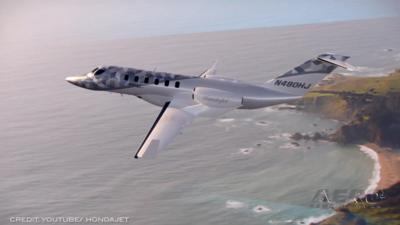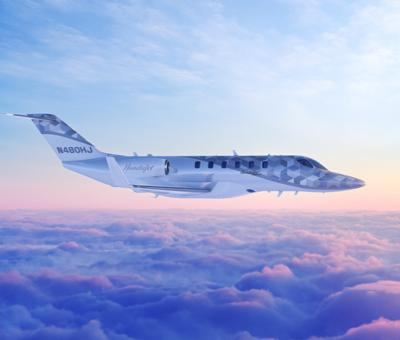11-Occupant, Single-Pilot, Coast-to-Coast Capabilities Claimed
HondaJet, the Greensboro, North-Carolina-headquartered aircraft manufacturer and maker of the successful HondaJet family of small twin-turbine aircraft, announced that it will presently add a midsize aircraft ostensibly capable of traversing the contiguous United States nonstop.

Honda Motor Company, the Japanese multinational conglomerate manufacturer of automobiles, motorcycles and power equipment, commenced development of the HondaJet in Greensboro in 2001. In 2006, confident it had conceived of a sound and marketable flying-machine, motor-vehicle titan founded the Honda Aircraft Company. The first HondaJet—the HA-420—entered service in December 2015. Two-years later, favorable reviews and brisk sales saw the HondaJet emerge as the world’s top-selling light business jet.
At 2021’s NBAA Business Aviation Convention & Exhibition (BACE), HondaJet introduced its HondaJet 2600 concept. The company disclosed the new model—which its engineers and management aspire to see FAA type certificated in 2028—will complement the existing HondaJet Elite II.
Currently, HondaJet employs some 1,500 personnel at its Greensboro plant. Whether or not the new aircraft will be produced in subject facility remains unknown.
Honda Aircraft Company president and CEO Hideto Yamasaki set forth in a press release: “The commercialization of our new light-jet represents Honda’s next chapter of skyward mobility, which further expands the potential of people’s lives. By building on the expertise behind our technological innovations, we will accelerate the development of the program with sustainability a key element throughout.”
In an email follow-up to Mr. Yamasaki’s statement, Honda Aircraft Company stated the 2600 model is to be “a light-jet with performances comparable to that of a medium-sized jet.” The company further stated the inchoate aircraft will be capable of “nonstop transcontinental flight.” Honda asserts—accurately—that its 2600 would be the world’s first light-jet capable of such a feat, adding the plane will accommodate up to 11 occupants yet remain legally operable by a single pilot.
Honda’s literature states the 2600 model will be powered by a pair of Williams International FJ44-4C turbofan engines, each producing 3,600-lbf. thrust. So motivated, the company claims the aircraft will cruise at 450-knots (0.67 Mach) and reach a service-ceiling of FL470. For the purpose of placating the eco-militant, Honda has loudly professed its commitment to “reducing carbon emissions,” crowing its new jet’s fuel-efficiency across a typical mission will be twenty-percent better than that of extant light-jets and forty-percent better than that of competing midsize jet aircraft.
The claimed capabilities, if veracious, trounce those of the company’s Elite II model, which carries a maximum of eight occupants—including crew.

Since its 2006 founding, Honda Aircraft has salted the general aviation’s turbine sector with innovations the likes of a unique, over-wing engine-mounting scheme; natural laminar-flow wings, and advanced carbon composite construction techniques. The HondaJet’s engine placement in particular overcame limitations by which legacy designs are plagued, and allowed for reduced wave-drag and increased cabin and baggage space. Honda Aircraft Company was also the first OEM to collaborate with Garmin for purpose of developing EFIS suites for general aviation jet aircraft. In recognition for its contributions to aircraft design and business aviation, the Honda Aircraft Company, in 2018, was awarded the American Institute of Aeronautics and Astronautics (AIAA) Foundation Award for Excellence.
As of December 2021, over two-hundred HondaJets had been delivered to private customers worldwide.
 ANN's Daily Aero-Term (05.29.25): Terminal Radar Service Area
ANN's Daily Aero-Term (05.29.25): Terminal Radar Service Area ANN's Daily Aero-Term (05.30.25): Very High Frequency (VHF)
ANN's Daily Aero-Term (05.30.25): Very High Frequency (VHF) Aero-News: Quote of the Day (05.30.25)
Aero-News: Quote of the Day (05.30.25) Airborne 05.23.25: Global 8000, Qatar B747 Accepted, Aviation Merit Badge
Airborne 05.23.25: Global 8000, Qatar B747 Accepted, Aviation Merit Badge ANN's Daily Aero-Linx (05.30.25)
ANN's Daily Aero-Linx (05.30.25)




